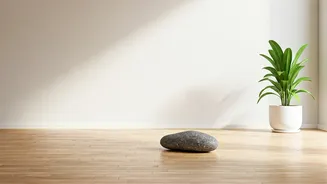Understanding Meditation Basics
Meditation, at its core, is a practice aimed at training the mind to focus and redirect thoughts. It is a technique that has been used for centuries across
different cultures to cultivate mindfulness and enhance overall well-being. Meditation involves various methods, each designed to achieve a state of mental clarity and emotional calmness. These practices can range from simple breath awareness to more complex visualizations and mantra repetitions. Regular practice has been shown to reduce stress, improve focus, and promote a sense of inner peace. To begin, find a quiet and comfortable space where you won't be disturbed. Sit or lie down in a position that allows you to relax fully. Gently close your eyes or fix your gaze softly on a point. The primary aim is to observe your thoughts without judgment, allowing them to pass without getting carried away. Should your mind wander, which it inevitably will, gently bring your attention back to your chosen focus, such as your breath, a mantra, or a specific image. Consistency is key, and even short, daily sessions can yield significant benefits over time, making meditation a valuable tool for mental and emotional health.
Cyclic Breathing Technique
Cyclic breathing is a specific technique that can greatly enhance meditation practice. It involves regulating the breath in a cyclical pattern to promote relaxation and focus. This technique is designed to calm the nervous system and quiet the mind, making it easier to enter a meditative state. To practice cyclic breathing, sit comfortably and close your eyes. Begin by taking a deep, slow breath through your nose, filling your lungs completely. Then, hold your breath for a few seconds before exhaling slowly through your mouth or nose. Focus on the sensation of your breath moving in and out, observing the natural rhythm. A common pattern involves inhaling for a count of four, holding for a count of two, and exhaling for a count of six. Adjust the counts to what feels comfortable and natural for you. The key is to maintain a smooth, steady rhythm. As you practice, you may notice a decrease in racing thoughts and an increase in mental clarity. Cyclic breathing can be used as a standalone practice or integrated into your meditation sessions. Regular practice helps reduce stress and cultivate mindfulness, improving overall mental and emotional well-being. By focusing on the breath, you can quiet the mind and create a sense of calm and presence.
Finding a Meditation Space
Creating a conducive environment is important for a successful meditation practice. Choosing the right space and setting is crucial for minimizing distractions and maximizing the benefits. The ideal meditation space should be quiet, comfortable, and free from interruptions. Find a spot in your home or another location where you can be undisturbed. This may be a dedicated room, a quiet corner, or even a specific area outdoors. Ensure the space is clean and well-ventilated. The surroundings should be aesthetically pleasing to you, as this can enhance relaxation. You might choose to add elements like soft lighting, calming colours, or natural elements such as plants or candles. The room's temperature should be comfortable, not too hot or cold. Once you have selected your space, you can set it up to meet your needs. Consider using a meditation cushion or chair to provide support and comfort during your practice. Some people find that specific sounds, like ambient music or nature sounds, can enhance their meditation. Other tools that can be helpful include incense, essential oils, or other objects that promote relaxation and focus. By establishing a designated meditation space, you signal to your mind and body that it is time to relax and focus. With a little effort, you can create a sanctuary that supports your practice and helps you to achieve greater mental and emotional well-being.
Immediate vs Long-term Effects
Meditation offers both immediate and long-term benefits for your mental and emotional health. The immediate effects are often noticeable shortly after a meditation session. These include a sense of calmness, reduced stress, and increased mental clarity. Many people find that meditation helps them to feel more grounded and present in the moment. The nervous system can experience an immediate calming effect, leading to a reduction in heart rate and blood pressure. Over time, regular meditation practice leads to more profound and lasting benefits. Long-term meditators often experience decreased anxiety and depression levels, enhanced emotional regulation, and improved cognitive function. Studies have shown that meditation can increase grey matter in the brain regions associated with attention and emotional processing. Consistent practice also fosters greater self-awareness and self-compassion. People who meditate regularly tend to be more resilient to stress and are better able to handle challenging situations. Long-term meditators also report an increased sense of overall well-being, improved sleep quality, and a greater capacity for empathy. The cumulative impact of meditation underscores its value for promoting lasting mental and emotional health.
Practical Applications: Daily Life
Integrating meditation into your daily life enhances the benefits and makes it a sustainable practice. Begin by establishing a regular schedule, even if it's just for a few minutes each day. The consistency is more important than the length of the session. The best time to meditate is when you are least likely to be interrupted. This may be in the morning, before starting your day, or in the evening, as a way to unwind. You can also incorporate short, mindful moments throughout the day. For example, take a few deep breaths before a meeting or during a stressful task. Utilize techniques like mindful walking or eating to bring your awareness to your current activities. This can include taking a walk while focusing on the sensations of each step or enjoying your meal, savoring each bite. If you find yourself feeling overwhelmed, take a break and sit quietly for a few minutes. Focus on your breath or a mantra to regain your composure. Consider using guided meditation apps or recordings to enhance your practice, especially when you are starting. Remember, meditation is not about emptying your mind, but about observing your thoughts without judgment. By integrating meditation into your daily routine, you can cultivate a sense of inner peace, improve your focus, and enhance your overall well-being. Making meditation a part of your daily routine will offer you tools to navigate the challenges of daily life with more ease and grace.











